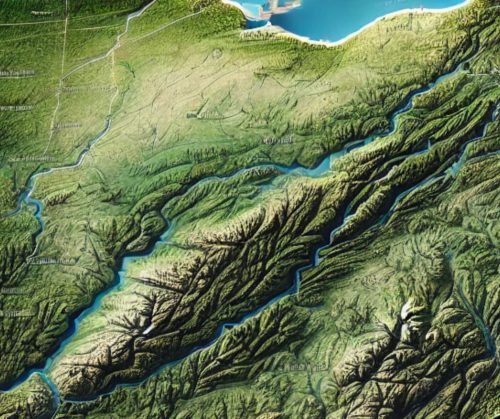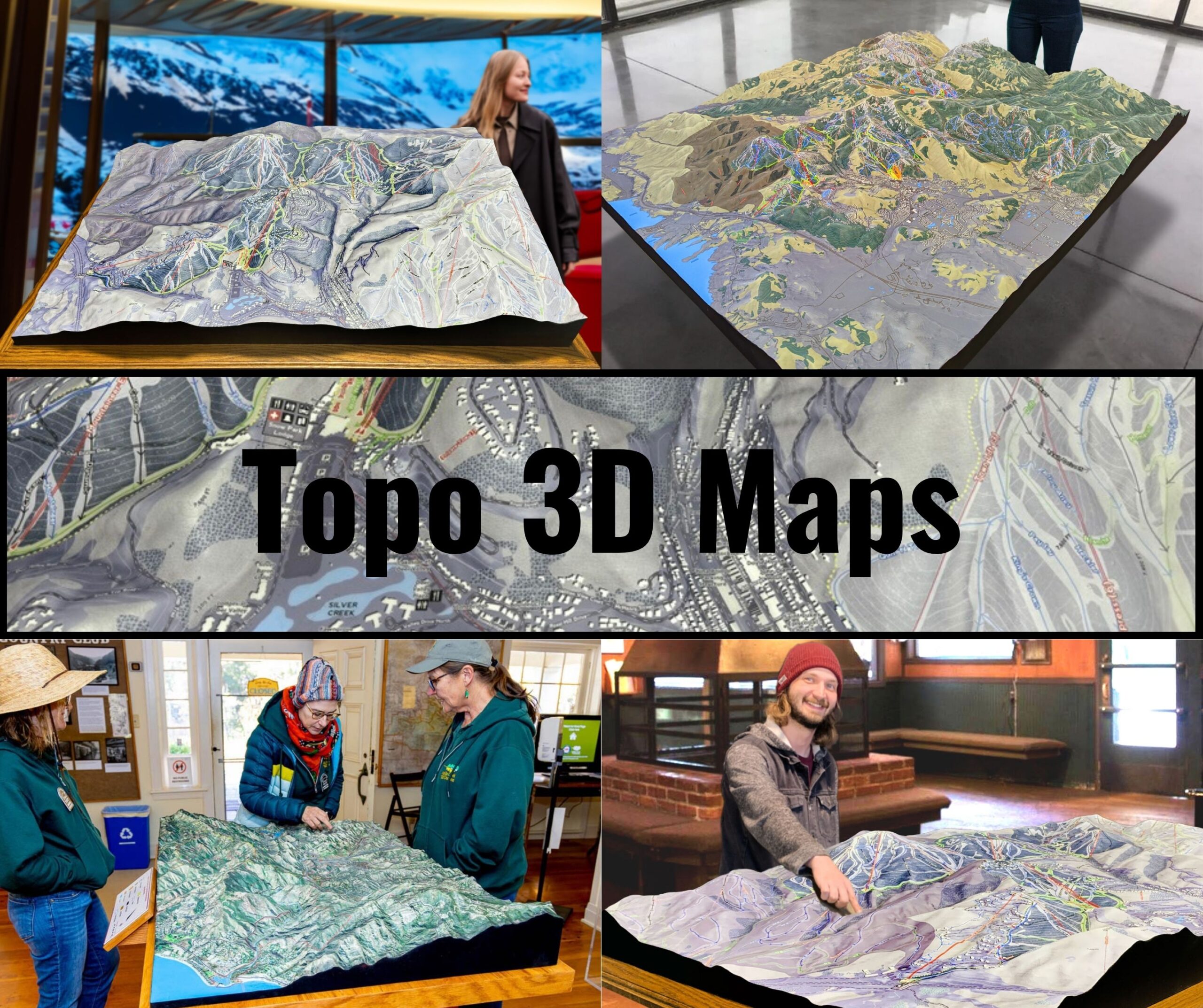Ohio Topo Map
Ohio Topo Map
We Build Custom 3D Topo Maps
Ohio Topo Maps: A Journey Through the Buckeye State’s Dynamic Landscapes
Ohio, often known as the Buckeye State, is a diverse tapestry of landscapes that range from the flat expanses of the Lake Erie shoreline to the rolling hills of the Appalachian Plateau. This geographic diversity creates a vibrant blend of agricultural fields, forested areas, urban hubs, and historic landmarks. Topographic maps are essential tools for unlocking and understanding these varied terrains, providing detailed depictions of Ohio’s contours, waterways, and elevations.
Ohio’s topographic maps, available in both 2D and 3D formats, are invaluable for adventurers, conservationists, educators, and geologists. These maps reveal the state’s hidden features, making it easier to navigate and appreciate its natural and cultural landscapes.
The Lake Erie Shoreline: Beaches, Bluffs, and Islands
The northern edge of Ohio borders Lake Erie, one of the Great Lakes. This region is characterized by sandy beaches, coastal wetlands, and limestone bluffs, offering stunning views and abundant recreational opportunities.
In 2D topographic maps, the Lake Erie shoreline is depicted with contour lines that highlight subtle elevation changes along the beaches and cliffs. Features such as the Marblehead Peninsula, the Cuyahoga River, and the Lake Erie Islands are prominently displayed, offering essential guidance for boaters, anglers, and conservationists.
3D topographic maps bring the shoreline to life, showcasing the interplay of land and water, the depth of harbors, and the intricate patterns of wetlands. These maps are essential for planning coastal activities and studying the ecological dynamics of this vital region.
The Appalachian Plateau: Rolling Hills and Ancient Forests
The southeastern part of Ohio is dominated by the Appalachian Plateau, a region of rolling hills, lush forests, and ancient rock formations. This area includes the Hocking Hills State Park, one of the state’s most popular outdoor destinations.
In 2D topographic maps, the Appalachian Plateau is represented with closely spaced contour lines that illustrate its rugged terrain and steep slopes. Features such as Old Man’s Cave, Rockbridge, and the Little Miami River are clearly marked, providing valuable insights for hikers and geologists.
3D topographic maps of the Appalachian Plateau highlight the depth of its gorges, the height of its ridges, and the intricate patterns of its river systems. These maps are invaluable for exploring the region’s natural beauty and planning outdoor adventures.
The Till Plains: Fertile Fields and Agricultural Heartlands
Central and western Ohio are part of the Till Plains, a region of flat to gently rolling terrain shaped by ancient glaciers. This area is the agricultural heartland of Ohio, producing corn, soybeans, and other crops.
In 2D topographic maps, the Till Plains are depicted with widely spaced contour lines that reflect their flat terrain. Features such as the Scioto River, farmsteads, and small towns are prominently displayed, offering a comprehensive view of this productive landscape.
3D topographic maps of the Till Plains emphasize the subtle elevation changes, the patterns of drainage systems, and the expansive farmlands. These maps are essential for land-use planning, agricultural management, and conservation efforts.
The Ohio River Valley: A Historic Waterway
The Ohio River, forming the state’s southern border, is one of the most historically and economically significant waterways in the United States. This region includes steep river bluffs, fertile floodplains, and bustling river towns.
In 2D topographic maps, the Ohio River Valley is depicted with contour lines that illustrate the elevation changes of its banks and surrounding hills. Features such as Portsmouth, Marietta, and the confluence of tributaries like the Muskingum River are clearly marked.
3D topographic maps of the Ohio River Valley provide a more immersive view, highlighting the depth of the river channel, the height of adjacent bluffs, and the extent of the floodplains. These maps are perfect for understanding the river’s ecological and economic impact.
Ohio’s Urban Centers: Topography in the Built Environment
Ohio’s urban areas, including Columbus, Cleveland, and Cincinnati, are intricately connected to the state’s natural geography. These cities are built on riverbanks, hills, and plains, showcasing a blend of natural and human-made features.
In 2D topographic maps, urban landscapes are represented with contour lines that detail elevation changes and features such as roads, parks, and waterways. Notable landmarks like the Cleveland Metroparks, Cincinnati’s Over-the-Rhine district, and Columbus’ Scioto Mile are prominently displayed.
3D topographic maps of Ohio’s urban centers provide a unique perspective, highlighting the interplay between natural topography and urban development. These maps are essential for urban planners, architects, and historians.
Ohio’s Glacial Features: Moraines, Kettles, and Eskers
The glacial history of Ohio is evident in its landforms, including moraines, kettles, and eskers. These features are scattered throughout the state, particularly in the northern and central regions.
In 2D topographic maps, glacial features are depicted with contour lines that detail their subtle shapes and elevations. Features such as the Great Black Swamp remnants, kames, and glacial ridges are clearly marked, offering valuable insights for geologists and conservationists.
3D topographic maps emphasize the contours and textures of these glacial landforms, providing a deeper understanding of Ohio’s Ice Age history. These maps are invaluable for educators and researchers studying the state’s geological past.
How Ohio Topo Maps Are Fabricated: Crafting Precision in 2D and 3D
Creating topographic maps of Ohio involves advanced technology, precise data collection, and skilled craftsmanship. From the flat Till Plains to the rugged Appalachian Plateau, Ohio’s varied terrain requires accurate and detailed mapping.
For 2D topographic maps, the process begins with data collection from sources such as satellite imagery, aerial surveys, and LiDAR (Light Detection and Ranging). This data is processed using Geographic Information Systems (GIS) software to create contour lines that represent changes in elevation. In Ohio, particular attention is given to capturing the subtle slopes of the plains, the steep ridges of the Appalachians, and the intricate river systems. Additional features such as trails, roads, and landmarks are added to create a comprehensive map.
Creating 3D topographic maps involves rendering elevation data into three-dimensional models. Advanced software translates the data into digital 3D representations, which can then be printed using 3D printers or displayed digitally for interactive exploration. For Ohio, special care is taken to highlight features such as the height of urban skylines, the depth of river valleys, and the undulating hills of the Appalachians.
Once the 3D maps are created, they are often painted and finished to enhance their visual appeal and highlight key features such as elevation changes, vegetation, and water bodies. These maps provide a tactile and immersive way to explore Ohio’s landscapes, making them invaluable for educators, researchers, and outdoor enthusiasts.
Ohio Topo Maps for Conservation, Recreation, and Education
Topographic maps play a vital role in conserving Ohio’s natural resources, supporting outdoor recreation, and educating people about the state’s geography. With its diverse ecosystems and historical significance, Ohio requires careful management to preserve its environment and heritage.
Conservationists use topographic maps to monitor changes in Ohio’s environment, plan restoration projects, and protect critical habitats. For example, in the Appalachian Plateau, these maps guide efforts to manage trails and protect forest health. Along Lake Erie, topographic maps are essential for studying erosion and restoring wetlands.
For adventurers, topographic maps are indispensable tools for exploring Ohio’s trails, waterways, and parks. Hikers rely on these maps to navigate the Hocking Hills or the Cuyahoga Valley National Park, while paddlers use them to plan routes along the Ohio or Scioto Rivers.
Conclusion: Ohio’s Landscapes Through the Lens of Topographic Maps
Ohio’s topographic maps reveal the state’s diverse and captivating landscapes in stunning detail. From the rolling hills of the Appalachian Plateau to the flat expanses of the Till Plains, the dynamic Lake Erie shoreline, and the historic Ohio River Valley, these maps capture the beauty and complexity of the Buckeye State.
Whether you’re an adventurer exploring Ohio’s natural wonders, a scientist studying its ecosystems, or an educator teaching geography, topographic maps provide an invaluable tool for understanding and appreciating the state’s terrain. With both 2D and 3D options available, these maps ensure that future generations can continue to explore, protect, and enjoy the landscapes that make Ohio unique.
Check out WhiteClouds’ 3D Maps for more information on Ohio topo maps.

